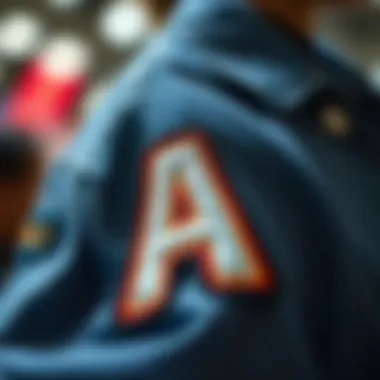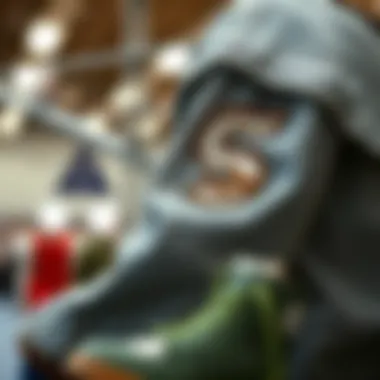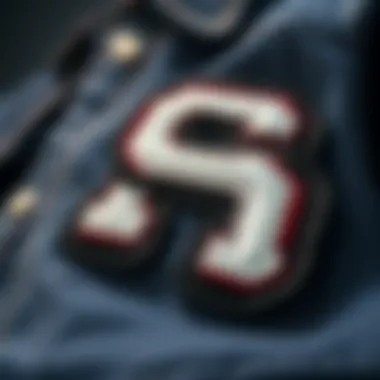Mastering Letter Patches: Techniques and Insights


Intro
Sewing letter patches has become a compelling way to express individual style, resonating across various demographics and fashion statements. These patches, often adorned with initials or meaningful words, carry personal significance that goes beyond mere aesthetics. In today's fast-paced fashion world, where fast fashion dominates, the slow and thoughtful art of hand-sewing these patches offers a refreshing contrast, presenting a canvas for creativity that is both personal and unique.
As we journey through this article, we shall dissect the intricate techniques involved, the materials necessary, and the rich cultural backdrop that informs this craft. Understanding this art form can empower both DIY enthusiasts and commercially oriented designers to find their voice and identity in their sartorial choices. It's not just about stitching patches onto garments; it's about weaving stories that reflect one's essence and experiences.
Fashion Tips
Incorporating letter patches into your wardrobe does not require a stylist’s touch or a degree from a fashion school. A few thoughtful approaches can elevate your style and make your outfits stand out.
Styling Techniques
When it comes to styling letter patches, less can often be more. Here are a few techniques to help you integrate them seamlessly:
- Mix and Match: Combine letter patches with various textures, such as denim and leather, to create a layered look. Consider using a denim jacket adorned with whimsical patches over a crisp white shirt.
- Statement Pieces: Use your patches as a focal point. A vibrant patch can transform a simple t-shirt into a statement piece that draws attention.
- Placement Matters: Think about where you place the patches. A pocket or shoulder area can draw eyes subtly, while a center placement on a back can make a bold assertion.
Must-Have Accessories
To complement your patched look, consider the following accessories:
- Confidence: No accessory surpasses the power of confidence when wearing your creations. Your attitude can enhance any garment's appeal.
- Layered Necklaces: A stack of delicate chains can add a touch of elegance, creating a more polished look.
- Vintage Bags: Opt for a vintage bag to frame your patched outfit, giving it an added layer of history and character.
Outfit Inspiration
Patterns emerge when you let creativity loose, encouraging styles that can fit various occasions. Here’s a little inspiration to get those wheels turning.
Seasonal Outfit Ideas
- Spring: Think a light denim jacket with patches over a floral dress. The juxtaposition can create a dynamic spring vibe.
- Summer: Pair a tank top with letter patches and high-waisted shorts, perfect for a casual beach day.
- Fall: Layer a cozy oversized sweater decorated with patches under a trench coat for a chic autumn look.
- Winter: Customize a beanie with patches alongside a long wool coat, it creates warmth that doesn't sacrifice style.
Versatile Wardrobe Essentials
- Classic Denim Jacket: A timeless piece, perfect as a base for various patches.
- Cargo Pants: These can easily accommodate patches; add them to the pockets for a rugged touch.
- Plain Sweatshirts: A blank canvas ready to come alive with your selected patches, easy for layering as the weather changes.
Understanding Letter Patches
In the realm of fashion, letter patches have emerged as more than mere embellishments. They serve as a canvas for personal expression and creativity, allowing wearers to make bold statements via their garments. Understanding letter patches goes beyond their aesthetic appeal; it encapsulates their cultural significance, their evolution over time, and the techniques involved in integrating them into clothing. This section lays the groundwork for comprehending the multifaceted aspects of letter patches, including their definitions, purposes, and historical context.
Definition and Purpose
Letter patches are fabric pieces typically adorned with initials, slogans, or symbolic designs, often stitched or ironed onto clothing items. These patches can be made from a variety of materials such as felt, embroidery thread, or even leather, and they come in diverse shapes and colors, enhancing their versatility.
The primary purpose of these patches is to personalize and customize clothing. Whether adhering to trends or making a statement about one's identity, letter patches open doors for self-expression. When someone sports a garment decorated with a particular patch, it often tells a story or conveys a sentiment that resonates with their individuality. For instance, a letter patch with the initials of a favorite brand can signify loyalty to that brand, whilst one with a motivational quote might project personal values or aspirations.
Furthermore, letter patches allow their users to engage in the dynamic world of fashion. For fashion designers and enthusiasts alike, they present opportunities for creativity—offsetting the conventionality of designs and inviting a fresh perspective on style. They can capture a specific mood or sense of belonging, reflecting one's interests or affiliations, be it with clubs, sports teams, or social movements.
Historical Context
The history of letter patches dates back many decades, weaving a narrative that reflects society's changing values. Initially popularized by military uniforms, these patches represented rank and achievements; they were often seen on the clothing of soldiers and pilots. Over time, as civilian fashion evolved, letter patches transitioned from military insignia to fashionable statements, taking on a life of their own in various subcultures.
During the 1960s and 70s, for example, letter patches found their way into the realm of counterculture. Punk rockers began using them to display rebellion against societal norms, sewing custom patches onto jackets as expressions of their ideology. This evolution continued into the 80s and 90s when hip-hop culture embraced letter patches, with artists and fans using them to showcase pride in their identity and affiliations with specific neighborhoods or crews.
In modern contexts, the resurgence of DIY culture and personal branding on social media platforms has given letter patches another lease on life. People are not only incorporating letter patches into streetwear, but they are also crafting personalized pieces that ignite conversations and connections with others. As a result, the act of using letter patches serves as a bridge between the past and the present, echoing themes of identity, community, and individuality.
"Letter patches encapsulate the essence of fashion—it's not just about what you wear; it's about what it says about you."
Understanding letter patches is essential for anyone involved in fashion. Whether one is a designer looking to innovate or a consumer aiming to enhance their wardrobe, recognizing the basics sets the foundation for meaningful engagement with this art form.
Materials Required for Sewing Letter Patches
Understanding the materials required for sewing letter patches is key to achieving a professional and aesthetic result. Each element plays a crucial role in facilitating the sewing process, ensuring longevity, and maintaining the overall appearance of the garment. It’s not just about having the right tools; it’s about choosing the best options that suit the fabric, patch type, and your own sewing skills.
Patch Types and Fabrics
When embarking on the sewing journey, first comes the selection of patches. They are generally made from a variety of fabrics such as twill, canvas, or felt. Twill patches, for example, are renowned for their durability and sleek finish. They often feature a unique diagonal weave, giving them a distinctive look. On the other hand, canvas patches offer a sturdier feel, making them suitable for outdoor wear or heavy-duty applications. Additionally, felt patches, soft and easy to sew, are great for casual styles but may not stand the test of time under heavy use.
In choosing your patches, consider not only the aesthetics but also the compatibility with the fabric of the garment it will be sewn onto. A smooth twill patch on a textured fabric may not adhere well, leading to future issues. Each patch’s fabric also plays a role in how easily it can be sewn. Choosing the right material means you must think about not just the appearance, but also the practicality and function of the patch when worn.
Tools and Equipment


The right tools can make or break your patch sewing experience. Essential tools for this craft include needles, threads, and sewing machines or hand sewing equipment. Each component shapes your execution and determines the overall finish.
Needles and Threads
In the world of sewing, needles and threads are like peanut butter and jelly; they come together in a beautiful harmony. However, not all threads are created equal. For patch sewing, a strong polyester thread is wisest as it offers durability and resilience against wear. A unique feature of polyester threads is their resistance to fading and shrinking, which is crucial if the garment is washed frequently.
When it comes to needles, a sharp or universal needle in sizes 80/12 to 90/14 works well, depending on the thickness of both your fabric and patch. A sharp needle cuts through the fabric, while a universal needle has a rounded point to manage various fabrics better. Using the correct needle and thread combination boosts your project’s longevity and keeps your sewing smooth.
Sewing Machines vs. Hand Sewing
Choosing between sewing machines and hand sewing can be a head-scratcher. Both methods have their pros and cons. A sewing machine can save time and provide a more uniform stitch, making it easier to work on larger patches or multiple pieces at once. However, it requires investment and space, which not everyone may have.
On the flip side, hand sewing allows for more precise control, especially for intricate designs. It can be a calm, meditative process, allowing for creativity to flow without the potential distractions of a machine. However, it may not provide the same level of strength in the stitches, especially on thicker fabrics or larger patches. Thus, the choice largely depends on your comfort level and how you envision the end result.
Embellishments and Additives
Adding embellishments like beads, sequins, or additional stitching can personalize your letter patches even further. These embellishments allow for a unique expression that can transform a simple patch into a statement piece. For example, outlining the letters in contrasting thread or adding texture with embroidery can elevate the patch’s appeal significantly.
Yet, it's worth noting that such additions can complicate the sewing process. They may require special threads or techniques, potentially stretching the time needed to complete the project. Weighing the pros and cons of embellishments is vital to ensure they enhance rather than overwhelm the original design.
"The materials you choose can be the fine line between a simple DIY and a wearable piece of art."
Techniques for Attaching Patches
Understanding the methods of attaching letter patches is essential for both novice and seasoned crafters. The right technique not only enhances the visual appeal of a garment but also ensures that patches remain secure over time. Different methods offer specific benefits that cater to various fabrics and patch types. A well-chosen technique can prevent frustrations and yield professional-looking results, which is crucial in the fast-paced world of fashion.
Direct Sewing Method
The direct sewing method is a timeless technique that involves sewing the patch directly onto the fabric. This approach is celebrated for its durability; once sewn, the patch is unlikely to peel or warp over time. There are a few important considerations in this method:
- Choosing the Right Needle: A universal needle generally works well, but if the fabric is heavy, you might consider a denim needle.
- Stitching Techniques: Using a straight stitch gives a clean edge, while a zigzag stitch can offer additional security for edges that might fray.
To start, position your patch where you want it on the garment, pin it into place, and sew around the edges. Be mindful of backstitching at both the starting and ending points to secure the thread. While it may take more time, especially on intricate designs, the direct sewing method contributes to a more lasting attachment.
Iron-On Application
Iron-on patches have gained popularity due to their ease of use. They save time, especially for those who might be less experienced with sewing. This method relies on heat-sensitive adhesive backing that bonds the patch to the fabric when pressed with an iron. Here are the steps for proper application:
- Preheat the Iron: Set your iron to the appropriate fabric setting. Avoid steam as moisture can weaken the adhesive.
- Position the Patch: Place the patch on the desired spot and, if necessary, use a cloth to protect your garment from direct heat.
- Apply Pressure: Use firm pressure and hold the iron in place for about 30 seconds. Ensure the edges are well adhered; you may need to repeat on tricky corners.
While iron-on patches are convenient, attention must be given to washing instructions afterward. Washing at high temperatures might weaken the bond.
A Combination Approach
The combination approach merges both the direct sewing and iron-on methods, offering the best of both worlds. Start with the iron-on application for an initial bond, then reinforce the edges with stitches to ensure long-lasting attachment. This technique is particularly useful when working with larger patches or if the fabric frequently stretches.
Benefits of this method include:
- Enhanced durability from both the heat bond and stitching completions.
- A polished look, as sewing can add decorative flair around the edges.
It can be especially beneficial in fashion-forward circles where items are often subjected to more wear and tear. In such cases, taking a little extra time can pay dividends in both aesthetics and lifespan.
"Choosing the right method for attaching patches can make or break your garment's style and longevity."
As you explore these techniques, consider not just how they affect the immediate aesthetic but how they align with the overall message you seek to convey through your fashion choices. Each method offers a unique perspective, so choose one that resonates best with your individual style and practical needs.
Styling with Letter Patches
Sewing letter patches onto garments has become a signature element in the contemporary fashion landscape. The implications of styling with letter patches extends beyond mere decoration; it transforms clothing into a canvas for personal expression and identity. Whether you’re looking to add a bit of whimsy to your wardrobe or to make a bold statement, letter patches can easily communicate who you are and what you value.
To the fashion-forward individual, styling these patches is not just about aesthetics but about weaving narratives into fabric. The versatility that letter patches offer allows one to blend various styles, from casual to edgy or even avant-garde. However, there are key nuances and considerations when blending these patches into personal fashion:
- Personalization: They allow for a deeply personal approach to fashion, reflecting tastes, hobbies, or sentiments.
- Layering Opportunities: Letter patches lend themselves well to layering, enabling a richer texture in outfits.
- Cultural Conversations: Patches can spark dialogues about societal norms, self-identity, and even nostalgia.
With these elements in mind, we will delve deeper into how letter patches influence three distinct styles: casual, streetwear, and high fashion.
Casual Style Integration
Integrating letter patches into casual wear can create a relaxed yet self-expressive vibe. Think about pairing embroidered initials or fun sayings with your standard pair of jeans and a white tee. It adds a sprinkle of charm without overwhelming the overall simplicity of the outfit.
Some practical ways to style casual outfits with letter patches include:


- T-shirts: Choose a fitted tee and iron on a patch that represents something you love—maybe your favorite band or a coffee alignment.
- Denim Jackets: This classic item is perfect for patches. A well-placed patch can turn an ordinary jacket into a memory-laden article.
- Canvas Sneakers: Adding a touch of flair with letter patches on the tongue or side of sneakers can uplift an otherwise mundane look.
Streetwear Influences
The streetwear scene has embraced patches with open arms, blending them into everyday outfits that resonate with a cool, urban vibe. Letter patches here serve to enhance the relaxed ambiance that streetwear champions. The graffiti-inspired aesthetics often found on the streets are reflected in the casual yet edgy use of patches.
Key considerations for incorporating letter patches into streetwear include:
- Oversized Apparel: Think oversized hoodies or baggy tees adorned with large patches. This trend emphasizes comfort while maintaining a strong visual impact.
- Layering Different Textures: Play with fabrics—try mixing denim, cotton, and leather to add depth. Patches placed on these diverse materials can stand out more vividly.
- Footwear and Accessories: High-tops or caps can also be fitted with patches. This not only completes the ensemble but also makes a bold statement.
High Fashion Considerations
The realm of high fashion takes a more curated approach to letter patches, often using them as a tool to evoke sophistication or irony within their collections. Designers may choose to sew letter patches on luxurious fabrics creating a contrast that turns heads.
When considering this style, keep in mind:
- Placement: Where the patch is placed can entirely change its significance. Opt for unexpected locations, such as the back of a gown or along a sleeve.
- Color Coordination: A sharp patch against a muted background can draw attention effectively. Utilize colour theory to your advantage, pairing hues that contrast or complement each other.
- Limited Spots: Use patches sparingly to maintain an air of exclusivity and refinement. A single well-placed patch can elicit more intrigue than several patches cluttering the outfit.
By embracing these varied styles, letter patches can morph from standard embellishments into critical components of fashion identity. As they cross boundaries from casual wear to street style and high fashion, these simple elements become powerful statements that challenge traditional concepts of elegance and personalization.
Cultural Significance of Patches
The cultural significance of patches can hardly be overstated in today’s fashion landscape. These small pieces of fabric do not merely serve a practical function; they carry narratives, sentiments, and identities that resonate deeply with individuals and communities. Sewing letter patches onto garments has transformed from a mere trend to a profound method of personal expression.
Expressing Identity
In a world where self-expression is paramount, patches act as miniature billboards of identity. When someone adorns their jackets, bags, or even hats with a letter patch, they convey a message about who they are or what they stand for. For example, wearing a patch of the letter "B" might signify affiliation with a particular sports team, while a "G" could express pride for a job or field of study. The use of letter patches has evolved to encompass a range of identities—cultural, professional, or personal, making them versatile tools for storytelling through fashion.
- Uniqueness: Each patch tells a story that’s unique to the wearer.
- Connection: They can connect the wearer to a community or movement.
- Rebellion: Moreover, patches are often used to challenge norms, as seen in punk and goth cultures.
Patches in Subcultures
Patches have long held a special place in subcultures, transforming outfits into symbols of cultural affiliation and rebellion. The punk scene, for example, prominently features patches that often bear anti-establishment slogans or symbols. For instance, the iconic band patches worn on leather jackets have become synonymous with musical genres; they tell the world that the wearer is part of a specific musical community that values originality and defiance.
Here are some noteworthy examples of subcultures using patches:
- Skate Culture: Patches on denim jackets often feature skate brands or slogans, creating a community identity among skaters.
- Military Influence: Historically, patches have indicated ranks and achievements, giving cloth a narrative deeper than fashion.
Personal Narrative through Patches
Each patch sewn onto fabric serves as part of a broader personal narrative. They remind the wearer of experiences, places, or moments that are significant. For instance, a patch representing a college can symbolize years of hard work, friends made, and memories created.
"Patches are like snapshots of your life experience sewn right into your clothes; they embody time, place, and feelings."
By integrating letter patches, one not only embellishes their clothing but also crafts a visual résumé of their journey. They become artifacts of personal history, and as one continues to add patches through life’s experiences, the garment evolves into a timeline of self-discovery and ambition.
In summary, the cultural importance of patches cannot be ignored. Letter patches provide a canvas for self-expression, a token of subcultural identity, and a storytelling tool that makes each garment uniquely yours. The deeper meanings behind these pieces of fabric add layers of significance to an item as simple as a jacket or backpack, elevating them from mere clothing to symbols of one’s very essence.
Common Mistakes and Troubleshooting
When delving into the art of sewing on letter patches, understanding common mistakes and troubleshooting is essential for achieving a polished and attractive finish. By navigating this process with care, you'll ensure that your creative vision comes to fruition without unnecessary setbacks. Here, we'll shine a light on some prevalent issues that sewists, both novice and seasoned, may encounter while working on letter patches. Grab a cup of coffee, and let’s dig in.
Misalignment Issues
Misalignment can be a real thorn in one’s side when sewing on patches. A simple error in placement can throw off the entire aesthetic of the piece. It happens more often than you think—perhaps you were rushing or distracted. That little patch that was supposed to be centered may now sit awkwardly to one side, altering the garment's balance. To prevent this:
- Measure twice, sew once: Just like a carpenter, it's always better to double-check your patch placement before you take that first stitch.
- Use fabric chalk or pins: Marking your fabric lightly with chalk or securing the patch with pins can help you visualize its position before committing to sewing.
- Practice makes perfect: If you’re new, consider practicing on a scrap piece of fabric first. This will allow you to refine your skills without the pressure of working on your final piece.
"Taking time to align properly can save a world of heartache later. No one wants to have to unpick stitches because of a few seconds of carelessness!"
Choosing the Right Thread
Choosing the right thread is another common pitfall. It may sound mundane, but thread is your lifeline in patch sewing. Not all threads are created equal; some are stronger, while others are more suited for delicate fabrics.
- Match your thread to your fabric: Picking a thread that matches the texture and weight of your fabric is vital. For heavy fabrics, consider using a thicker thread like cotton or polyester, while lighter fabrics may do well with a finer thread.
- Color choice matters: It may be tempting to grab any old spool, but your thread color can make or break the visibility of your stitches.
- Test thread during application: Before diving headfirst into your project, run a few test stitches on a scrap piece. This way you can see how the thread behaves on the fabric and adjust as needed.
- Opt for matching colors for a seamless look.
- Contrasting colors can add a bit of flair but should be used wisely.
Avoiding Fabric Damage


Nothing is worse than damaging a beloved fabric while sewing on a patch. The needle, while a powerful tool, can just as easily rip or snag the fabric. Here’s how to keep your fabric safe during the process:
- Choose the right needle: Select a needle that is appropriate for the weight of the fabric. A universal needle may work for most applications, but specific materials might require specialized needles.
- Mind the tension: Incorrect thread tension can lead to puckering or even tearing. Ensure that both the top and bobbin thread tensions are set correctly to avoid fabric distortion.
- Gentle touches: Don't pull or tug the fabric while sewing, especially around the patches. Let the machine do the work; too much force can result in damage.
In summary, being aware of these common pitfalls in sewing letter patches can streamline your process, allowing for a more enjoyable experience and more satisfying results. Troubleshooting these issues as they arise ensures that you can focus on what truly matters: expressing your creativity through your unique designs.
Maintenance of Patches
Maintaining your patches is as crucial as choosing the right ones to adorn your garments. A well-maintained patch not only keeps its vibrant colors and neat appearance but also extends the life of the fabric underneath. Let’s dive into some critical factors that will help you keep your letter patches looking sharp and fresh.
Washing and Care Techniques
Proper washing techniques are essential to prolong the life of your patches. Here are some considerations to keep in mind:
- Hand Washing: Whenever possible, opt for hand washing to preserve both fabric and thread integrity. Fill a basin with cool water and a gentle detergent, gently agitating the garment. Avoid excessive friction which can fray edges.
- Cold Water Cycle: If machine washing is necessary, always select a cold water cycle. Hot water can cause fabrics to shrink and patches to lose their adhesive properties.
- Inside Out: Turning your garment inside out minimizes wear and tear on the patch by preventing direct contact with the agitators in a washing machine.
- Air Drying: Instead of using a dryer, hang your garment to air dry. Excess heat can cause patches to warp and adhesive to weaken, leading to potential detachment.
Utilizing these techniques ensures that your patches maintain their aesthetic appeal while keeping the overall garment intact and wearable.
Repairing Damaged Patches
Despite our best efforts, patches can get damaged over time. Whether it’s from washing mistakes or snagging on something sharp, knowing how to repair them can save you money and preserve your style. Here are some helpful tips:
- Re-Sewing Loose Edges: If a patch starts to lift at the edges, don't panic. Using a needle and sturdy thread, sew around the perimeter of the patch, making small, close stitches. This can often reinstate the patch securely.
- Fabric Glue Tricks: For minor detachment, fabric glue can be a quick fix. Apply a thin, even layer underneath the patch and press firmly; a heavy book can be used to weigh it down as it dries.
- Replacing or Covering Damaged Areas: If the patch is beyond repair due to significant wear or fraying, consider sewing a new patch on top, or even covering it with a decorative element like embroidery or an appliqué.
Remember, maintaining your patches is about attention to detail. Keeping an eye on them during your regular fabric care routine can save you stress later on.
"Maintaining your patches not only reflects your style but also tells a story of care and appreciation for your garments."
For more insights on garment care, visit Wikipedia or check out forums like Reddit for community tips.
Future Trends in Patch Usage
As fashion continues to evolve, the role of patches, especially letter patches, is becoming more intricate and multifaceted. Understanding future trends in patch usage isn’t just an exercise in style; it’s a glimpse into where the industry is headed, blending creativity with responsibility. Designers, stylists, and marketers alike need to pay attention as these trends shape how garments are personalized and perceived.
Sustainable Practices
The push toward sustainability in fashion is not just a passing fad; it’s becoming a critical tenet of the industry. Embracing sustainable practices when using letter patches can make garments not only more eco-friendly but also resonate better with conscious consumers. One approach is utilizing organic materials for producing patches, reducing reliance on synthetic fibers which can leak microplastics during washing.
Consider patches made from organic cotton or recycled polyester. These choices not only cut down on waste but also align with a growing demand for environmentally-friendly options among fashion enthusiasts.
- Reclaimed Fabrics: Designers are increasingly using scraps and second-hand garments to craft fresh patches, turning potential waste into distinct fashion statements.
- Eco-Friendly Adhesives: When using iron-ons, opting for eco-conscious adhesives can diminish harmful effects on the environment.
Moreover, brands that champion sustainability can gain a competitive edge by sharing their journey of creating eco-friendly patches. This transparency builds trust and loyalty. Sustainability isn’t merely a trend; it’s an opportunity to innovate.
"The future of fashion lies in its ability to weave sustainability into creativity, allowing patches to echo the ethos of mindful consumption."
Technological Innovations
Advancements in technology are revolutionizing how letter patches are designed and applied to garments. The introduction of digital printing technology, for example, enables intricate designs that were once labor-intensive to be produced efficiently and at a lower cost.
Additionally, 3D printing is making waves in patch production, allowing for unique textures and shapes that challenge traditional flat patches. With 3D-printed patches, designers can experiment with silhouettes that pop out from the fabric, adding a fresh dimension to style. Such innovations also lead to reduced production waste, benefitting both the maker and the planet.
- Customized Patch Creation: Online platforms now allow consumers to create personalized patches that are custom-ordered via easy-to-use interfaces. This puts creativity directly in the hands of consumers, allowing them to express their individuality in ways that were previously hindered.
- Smart Textiles: The rise of smart textiles may soon facilitate patches that can change color or respond to environmental factors, incorporating both function and flair.
The intersection of fashion and technology is broadening the canvas for expression, unlocking endless possibilities for letter patches in personal style. As these trends unfold, it is essential for industry insiders to adapt and explore how innovation can elevate the humble patch to new heights.
Final Thoughts on Personalizing Garments
Personalizing garments is not just about aesthetics; it’s an expression of individuality and identity. In this discussion, we see how the practice of sewing letter patches serves as more than a decorative choice. It invites creativity, storytelling, and self-affirmation through fashion. The incorporation of letter patches allows individuals, whether they are designers, stylists, or everyday wearers, to curate a wardrobe that is not just functional but also imbued with meaning. The act of sewing patches provides an opportunity to reflect personal values, interests, and experiences.
Encouraging Creativity
Creativity in fashion is often stifled by commercial trends and mass production. Letter patches burst this bubble, encouraging wearers to experiment with their clothing. Each patch sewn can signify a personal story, a trend, or a fond memory, making garments truly unique. For those who enjoy DIY, letter patches add a hands-on element to fashion, transforming a standard piece into a canvas for artistic expression.
- Experimentation: Don’t be afraid to mix different colors and fonts. A bright neon letter against a denim jacket can create a bold statement.
- Storytelling: Use patches to tell a story about yourself—be it hobbies, places visited, or life milestones. Each patch can hold significance.
- Collaboration: Join creative communities, such as sewing groups on Reddit or platforms like Facebook, where users share techniques and inspirations.
In cultivating creativity, individuals can break the norm and redefine their style. This does not just apply to high-fashion contexts but extends into daily wear, making even the simplest outfit resonate with personality.
Building a Unique Wardrobe
A unique wardrobe doesn’t happen overnight; it’s a process of curating pieces that resonate with one’s style and values. Letter patches contribute significantly to this journey, providing flexibility to mix and match. They offer a fantastic way to elevate basic pieces, allowing a person to stand out in a crowd.
To build a truly unique wardrobe:
- Choose a Base: Start with simple and versatile garments like t-shirts or jackets. Neutral tones often work best.
- Select Meaningful Patches: Pick patches that represent your interests or affiliations—perhaps the initials of a beloved band or a phrase that inspires you.
- Layer and Combine: Experiment by layering different patches on various garments. Don’t shy away from creativity; let imagination guide your combinations.
- Assess and Adapt: As your style evolves, replace patches or switch them up to reflect your current taste, ensuring relevance and freshness.
Ultimately, personalizing garments using letter patches is a fulfillment of self-expression. This act transforms mere clothing into pieces that harmonize with personal narratives and experiences. It’s about embracing what is uniquely you, establishing a wardrobe that is as diverse and dynamic as your life itself.















